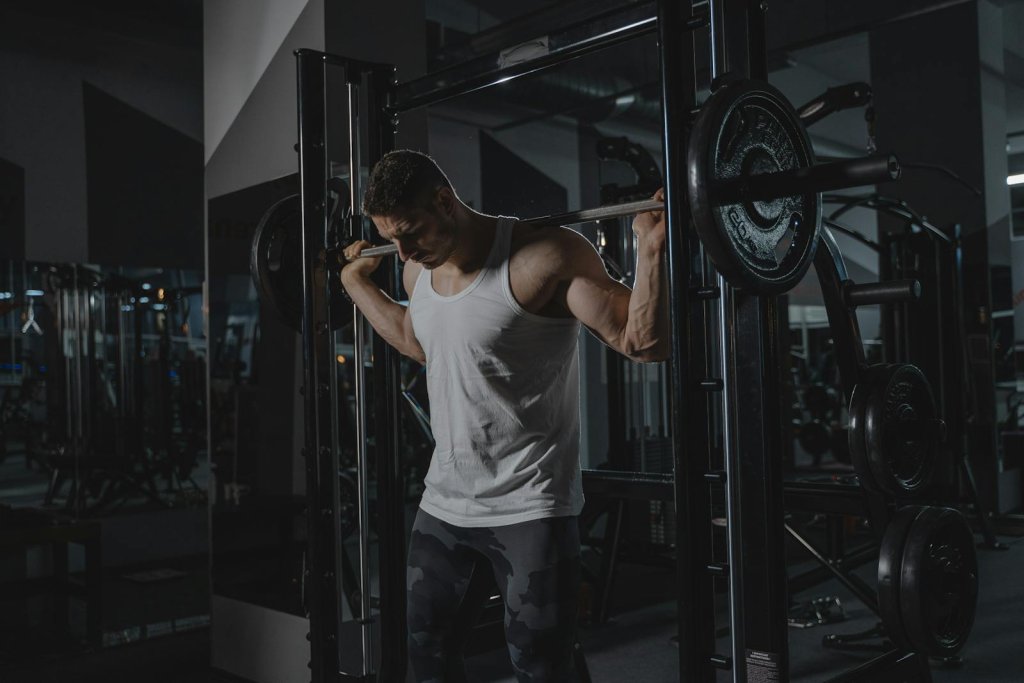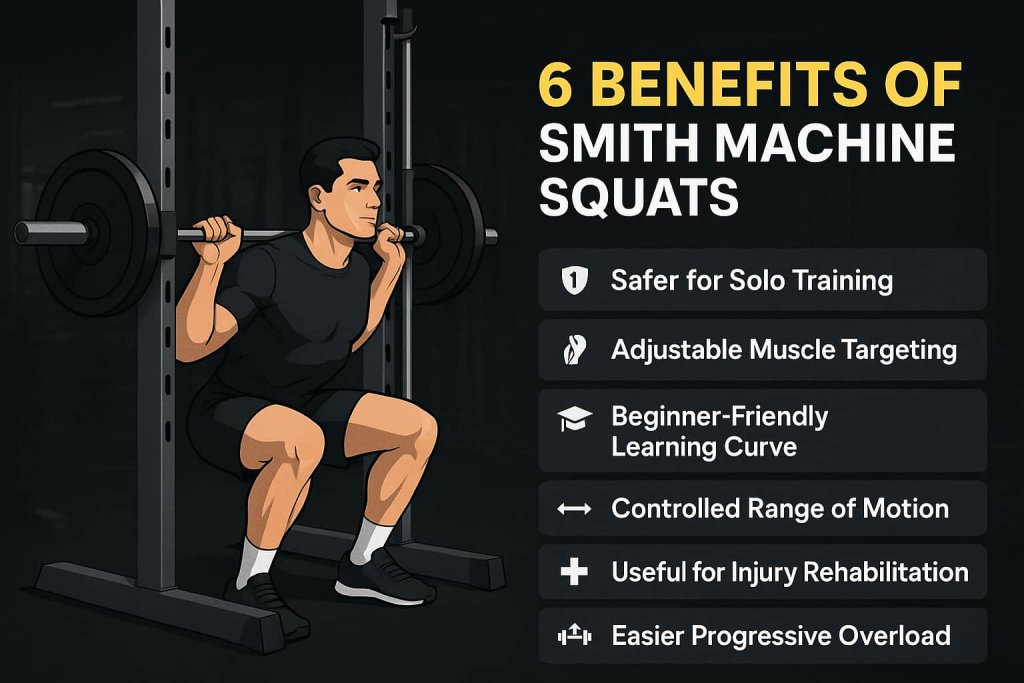Smith machine squats are a safe, controlled, and highly effective way to build lower-body strength — especially for beginners, solo lifters, or those recovering from injury.
With its fixed bar path, built-in safety hooks, and reduced balance demands, the Smith machine allows you to squat with confidence and precision. While it can’t fully replace free-weight squats for functional strength, it excels as a muscle-building, form-teaching, and safety-conscious choice for many lifters.

Understanding how to use Smith machine squats correctly is crucial if you want to avoid joint strain, maximize muscle activation, and get the most out of your leg workouts. In this comprehensive guide, you’ll learn what they are, why they’re worth doing, step-by-step technique, common mistakes, variations, pros and cons, and expert-backed training tips.
What Is a Smith Machine Squat?
A Smith machine squat is a squat variation performed on a machine with a barbell fixed to vertical guide rails.
This design keeps the bar moving in a straight, controlled path, reducing the need for stabilizer muscles to balance the weight.
Key differences from barbell squats:
- The bar moves in a fixed path instead of a free range.
- Safety hooks allow you to rack the bar at any point.
- Foot placement can be adjusted more freely to target different muscles.
- It allows you to train heavier without worrying about balance.
While some lifters criticize the Smith machine for not engaging stabilizers, others use it strategically for isolation, hypertrophy, and safety.
Benefits of Smith Machine Squats

1. Safer for Solo Training
If you train without a spotter, the Smith machine’s built-in safety catches mean you can lift heavy without the risk of getting pinned under the bar.
2. Adjustable Muscle Targeting
By moving your feet forward or backward, you can shift emphasis:
- Feet forward: Glutes and hamstrings take more of the load.
- Feet directly under hips: Quads become the primary movers.
- Wide stance: More inner thigh and adductor activation.
3. Beginner-Friendly Learning Curve
New lifters can learn squat form without worrying about balancing the bar. This allows for better depth practice and improved posture.
4. Controlled Range of Motion
The fixed track ensures consistent bar movement, helping prevent wobbling or tipping that can lead to poor form or injury.
5. Useful for Injury Rehabilitation
Athletes recovering from lower-back or knee injuries often use the Smith machine (under supervision) to maintain leg strength with reduced stabilization demands.
6. Easier Progressive Overload
Since balance is less of an issue, you can add weight more quickly and focus purely on pushing your leg muscles to adapt.
How to Do Smith Machine Squats with Perfect Form
Step 1 — Set Up the Machine
- Adjust the bar height so it’s just below shoulder level.
- Load the bar with appropriate weight and set safety stops if your machine has them.
Step 2 — Position Yourself
- Stand under the bar so it rests comfortably across your traps (high-bar) or rear delts (low-bar).
- Grip the bar slightly wider than shoulder-width.
- Place your feet based on your target muscles.
Step 3 — Unrack the Bar
- Rotate the bar forward to unlock it.
- Brace your core and keep your chest lifted.
Step 4 — Controlled Descent
- Lower yourself by bending hips and knees simultaneously.
- Keep knees tracking over toes.
- Aim for thighs parallel to the floor or deeper if mobility allows.
Step 5 — Drive Up
- Push through your heels to return to standing.
- Avoid locking knees completely to maintain tension.
Trainer Tip: Keep your core engaged and spine neutral from start to finish.
Common Mistakes to Avoid
- Knees Caving In – Increases injury risk; keep knees aligned with toes.
- Bouncing at the Bottom – Can strain joints; control the descent.
- Feet Too Far Back – May overload the knees; adjust stance for comfort.
- Locking Out Knees – Reduces muscle tension and may strain joints.
- Overloading Too Soon – Learn form before stacking heavy plates.
Popular Smith Machine Squat Variations
1. Front Smith Squat
Why it works: The bar is held in a front rack position (resting across the front of your shoulders), which shifts the center of gravity forward. This increases quad activation while also heavily engaging the core to keep the torso upright.
How to do it:
- Set the Smith bar at shoulder height.
- Step under the bar, placing it across the front of your shoulders. Cross your arms or use a clean grip to hold it in place.
- Keep your elbows high, chest up, and core braced.
- Squat down until thighs are parallel or slightly below, then drive back up through your heels.
Pro Tip: Start lighter than you would with a back squat—front-loading demands more core and upper-back strength.
Best for: Quad hypertrophy, posture improvement, and athletes looking to strengthen their upright squat mechanics.
2. Bulgarian Split Squat (Smith Machine)
Why it works: By keeping one foot elevated behind you, this single-leg variation improves balance, coordination, and unilateral strength. The fixed Smith path removes the need to stabilize the bar, letting you focus on depth and load.
How to do it:
- Place a bench or platform about 2–3 feet behind you.
- Set the Smith bar at upper-chest height.
- Position one foot on the bench and the other directly under the bar.
- Unrack, descend until your front thigh is parallel to the floor, then push through your heel to return to standing.
Pro Tip: Keep your torso upright to hit the quads more, or lean slightly forward to engage more glutes and hamstrings.
Best for: Correcting muscle imbalances, improving athletic performance, and enhancing single-leg strength.
3. Sumo Smith Squat
Why it works: The extra-wide stance with toes turned out places more emphasis on the adductors (inner thighs) and glutes, while still targeting the quads and hamstrings.
How to do it:
- Set the bar at shoulder height and stand with feet wider than shoulder-width.
- Toes should point out at about 30–45 degrees.
- Lower slowly, pushing knees out in line with your toes.
- Drive upward, squeezing your glutes at the top.
Pro Tip: Avoid letting your knees cave inward—maintain outward pressure throughout the movement.
Best for: Building inner thigh strength, improving hip mobility, and adding variety to lower-body training.
4. Tempo Smith Squat
Why it works: Using a controlled eccentric phase (3–5 seconds lowering) maximizes time under tension, which stimulates greater muscle growth and improves control at weaker points.
How to do it:
- Choose your preferred stance (back, front, or sumo).
- Descend slowly for 3–5 seconds, pausing briefly at the bottom.
- Drive back up with controlled speed.
Pro Tip: Drop your working weight by 20–30% compared to regular squats—tempo squats are more demanding.
Best for: Hypertrophy, improving squat form, and increasing mind-muscle connection.
5. Reverse-Band Smith Squat
Why it works: Attaching resistance bands from the top of the machine makes the load lighter at the bottom (where you’re weakest) and heavier at the top (where you’re strongest). This allows you to handle heavier weights and overload the quads and glutes through the full range.
How to do it:
- Secure strong bands from the top of the Smith machine to each end of the bar.
- Set your preferred squat stance.
- As you descend, the bands help lift some of the load; as you rise, the tension decreases, forcing you to work harder.
Pro Tip: Perfect for breaking through plateaus and training explosiveness.
Best for: Advanced lifters looking to improve lockout strength and overload their quads and glutes without excessive strain on the joints.
Pros and Cons of Smith Machine Squats
| Pros | Cons |
|---|---|
| Safer for solo lifting | Less stabilizer muscle engagement |
| Great for beginners | Fixed bar path can feel unnatural |
| Adjustable stance for targeting | Doesn’t fully mimic real-life movement |
| Useful for rehab and hypertrophy | Can lead to overreliance if overused |
Expert Training Tips
- Use as an accessory lift — Pair with free-weight squats for balanced development.
- Go for higher reps — The stability lets you push volume for hypertrophy.
- Focus on form — Don’t let the fixed path encourage sloppy mechanics.
- Add pause squats — Pausing at the bottom increases muscle activation.
FAQs
1. Are Smith machine squats better than barbell squats?
Not better, just different — Smith squats are safer for solo training but less functional.
2. Can Smith machine squats build muscle?
Yes. They effectively target quads, glutes, and hamstrings with proper overload.
3. Where should my feet be?
Directly under hips for quads, slightly forward for glutes and hamstrings.
4. Are Smith squats bad for knees?
No, if done with proper stance and depth. Avoid extreme forward knee travel.
5. How much does the Smith machine bar weigh?
Typically 15–25 lbs, depending on brand and counterbalance.
6. Should beginners start with the Smith machine?
Yes — it’s a safe way to learn depth and form.
7. Can I replace all squats with Smith squats?
No — mix them with free-weight squats for full strength development.
Conclusion
Smith machine squats are a powerful tool for building lower-body strength in a controlled, safe environment. They’re beginner-friendly, effective for muscle isolation, and invaluable for solo training or rehabilitation. However, they should complement, not replace, free-weight squats for the best functional and athletic results.
